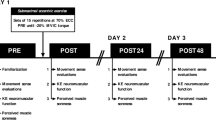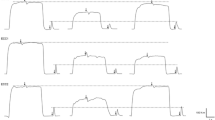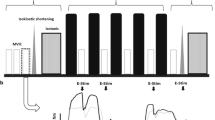Abstract
Purpose
This study examined eccentric-induced fatigue effects on knee flexor (KF) neuromuscular function and on knee position sense. This design was repeated across two experimental sessions performed 1 week apart to investigate potential repeated bout effects.
Methods
Sixteen participants performed two submaximal bouts of KF unilateral eccentric contractions until reaching a 20% decrease in maximal voluntary isometric contraction force. Knee position sense was evaluated with position-matching tasks in seated and prone positions at 40° and 70° of knee flexion so that KF were either antagonistic or agonistic during the positioning movement. The twitch interpolation technique was used to assess KF neuromuscular fatigue. Perceived muscle soreness was also assessed. Measurements were performed before, immediately (POST) and 24 h after (POST24) each eccentric bout.
Results
No repeated bout effect on neuromuscular function and proprioceptive parameters was observed. At POST, central and peripheral factors contributed to the force decrement as shown by significant decreases in voluntary activation level (− 3.8 ± 4.8%, p < 0.01) and potentiated doublet torque at 100 Hz (− 10 ± 15.8%, p < 0.01). At this time point, position-matching errors significantly increased by 1.7 ± 1.9° in seated position at 40° (p < 0.01). At POST24, in presence of muscle soreness (p < 0.05), although KF neuromuscular function had recovered, position-matching errors increased by 0.6 ± 2.6° in prone position at 40° (p < 0.01).
Conclusion
These results provide evidence that eccentric-induced position sense alterations may arise from central and/or peripheral mechanisms depending on the testing position.




Similar content being viewed by others
Data availability
The datasets generated during and/or analyzed during the current study are available from the corresponding author on reasonable request.
Abbreviations
- ANOVA:
-
Analysis of variance
- BF:
-
Biceps femoris
- CAR:
-
Central activation ratio
- Dtsup :
-
Superimposed doublet torque at 100 Hz
- Dt10Hz :
-
Potentiated doublet amplitude at 10 Hz
- Dt100Hz :
-
Potentiated doublet torque at 100 Hz
- ECC1:
-
First bout of submaximal eccentric contractions
- ECC2:
-
Second bout of submaximal eccentric contractions
- JPM:
-
Joint position-matching
- JPMS40 :
-
Joint position-matching in seated position at 40° of knee flexion
- JPMS70 :
-
Joint position-matching in seated position at 70° of knee flexion
- JPMP40 :
-
Joint position-matching in prone position at 40° of knee flexion
- JPMP70 :
-
Joint position-matching in prone position at 70° of knee flexion
- KF:
-
Knee flexors
- MVIC:
-
Maximal voluntary isometric contraction
- M-wave:
-
Maximal compound muscle action potentials
- RMS:
-
Root mean square
- Twpot :
-
Potentiated single twitch
- VA:
-
Voluntary activation level
- η 2 p :
-
Partial eta-squared
- 1RM ECC:
-
Eccentric unilateral 1 repetition maximum
References
Allen DG, Lamb GD, Westerblad H (2008) Skeletal muscle fatigue: cellular mechanisms. Physiol Rev 88:287–332. https://doi.org/10.1152/physrev.00015.2007
Allen TJ, Leung M, Proske U (2010) The effect of fatigue from exercise on human limb position sense. J Physiol 588:1369–1377. https://doi.org/10.1113/JPHYSIOL.2010.187732
Askling CM, Tengvar M, Thorstensson A (2013) Acute hamstring injuries in Swedish elite football: a prospective randomised controlled clinical trial comparing two rehabilitation protocols. Br J Sports Med 47:953–959. https://doi.org/10.1136/bjsports-2013-092165
Banks RW, Ellaway PH, Prochazka A, Proske U (2021) Secondary endings of muscle spindles: Structure, reflex action, role in motor control and proprioception. Exp Physiol 106:2339–2366. https://doi.org/10.1113/EP089826
Baumert P, Temple S, Stanley JM et al (2021) Neuromuscular fatigue and recovery after strenuous exercise depends on skeletal muscle size and stem cell characteristics. Sci Rep 11:7733. https://doi.org/10.1038/S41598-021-87195-X
Behrens M, Mau-Moeller A, Bruhn S (2012) Effect of exercise-induced muscle damage on neuromuscular function of the quadriceps muscle. Int J Sports Med 33:600–606. https://doi.org/10.1055/s-0032-1304642
Bewick GS, Banks RW (2021) Spindles are doin’ it for themselves: glutamatergic autoexcitation in muscle spindles. J Physiol 599:2781–2783. https://doi.org/10.1113/JP281624
Brownstein CG, Rimaud D, Singh B et al (2021) French translation and validation of the rating-of-fatigue scale. Sport Med Open 7:1–9. https://doi.org/10.1186/S40798-021-00316-8/FIGURES/3
Cohen J (1988) Statistical power analysis for the behavioral sciences, 2nd edn. Lawrence Erlbaum Associates, Hillsdale, NJ
Corcelle B, Morin JB, Gerus P et al (2022) New field ergometer to reproducibly measure maximum strength and rate of force development of hamstrings. Sci Sports. https://doi.org/10.1016/J.SCISPO.2022.03.005
Da Silva F, Monjo F, Zghal F et al (2021) Altered position sense after submaximal eccentric exercise-inducing central fatigue. Med Sci Sports Exerc 53:218–227. https://doi.org/10.1249/MSS.0000000000002444
Da Silva F, Colson SS, Zghal F et al (2022) Immediate voluntary activation deficits following submaximal eccentric contractions of knee extensors are associated with alterations of the sense of movement. Sci Rep 12:1–10. https://doi.org/10.1038/s41598-022-06081-2
Gandevia S (2001) Spinal and supraspinal factors in human muscle fatigue. Physiol Rev 81:1725–1789. https://doi.org/10.1152/physrev.2001.81.4.1725
Gilhodes JC, Roll JP, Tardy-Gervet MF (1986) Perceptual and motor effects of agonist-antagonist muscle vibration in man. Exp Brain Res 61:395–402. https://doi.org/10.1007/BF00239528
Givoni NJ, Pham T, Allen TJ, Proske U (2007) The effect of quadriceps muscle fatigue on position matching at the knee. J Physiol 584:111–119. https://doi.org/10.1113/jphysiol.2007.134411
Goodall S, Thomas K, Barwood M et al (2017) Neuromuscular changes and the rapid adaptation following a bout of damaging eccentric exercise. Acta Physiol 220:486–500. https://doi.org/10.1111/apha.12844
Gregory JE, Brockett CL, Morgan DL et al (2002) Effect of eccentric muscle contractions on Golgi tendon organ responses to passive and active tension in the cat. J Physiol. https://doi.org/10.1013/jphysiol.2001.012785
Hermens HJ, Freriks B, Disselhorst-Klug C, Rau G (2000) Development of recommendations for SEMG sensors and sensor placement procedures. J Electromyogr Kinesiol 10:361–374. https://doi.org/10.1016/s1050-6411(00)00027-4
Hillier S, Immink M, Thewlis D (2015) Assessing proprioception: a systematic review of possibilities. Neurorehabil Neural Repair 29:933–949. https://doi.org/10.1177/1545968315573055
Hyldahl RD, Chen TC, Nosaka K (2017) Mechanisms and mediators of the skeletal muscle repeated bout effect. Exerc Sport Sci Rev 45:24–33. https://doi.org/10.1249/JES.0000000000000095
Kent-Braun JA, Le Blanc R (1996) Quantitation of central activation failure during maximal voluntary contractions in humans. Muscle Nerve 19:861–869. https://doi.org/10.1002/(sici)1097-4598(199607)19:7%3C861::aid-mus8%3E3.0.co;2-7
Marshall PWM, Lovell R, Jeppesen GK et al (2014) Hamstring muscle fatigue and central motor output during a simulated soccer match. PLoS ONE 9:e1027. https://doi.org/10.1371/JOURNAL.PONE.0102753
Martin V, Millet GY, Martin A et al (2004) Assessment of low-frequency fatigue with two methods of electrical stimulation. J Appl Physiol 97:1923–1929. https://doi.org/10.1152/JAPPLPHYSIOL.00376.2004
Martin V, Dousset E, Laurin J et al (2009) Group III and IV muscle afferent discharge patterns after repeated lengthening and shortening actions. Muscle Nerve 40:827–837. https://doi.org/10.1002/mus.21368
Micklewright D, St Clair Gibson A, Gladwell V, Al Salman A (2017) Development and validity of the rating-of-fatigue scale. Sport Med 47:2375–2393. https://doi.org/10.1007/s40279-017-0711-5
Paschalis V, Nikolaidis MG, Giakas G et al (2008) Position sense and reaction angle after eccentric exercise: the repeated bout effect. Eur J Appl Physiol 103:9–18. https://doi.org/10.1007/S00421-007-0663-9
Place N, Millet GY (2020) Quantification of neuromuscular fatigue: what do we do wrong and why? Sport Med 50:439–447. https://doi.org/10.1007/s40279-019-01203-9
Prasartwuth O, Suteebut R, Chawawisuttikool J et al (2019) Using first bout effect to study the mechanisms underlying eccentric exercise induced force loss. J Bodyw Mov Ther 23:48–53. https://doi.org/10.1016/j.jbmt.2017.11.008
Proske U (2019) Exercise, fatigue and proprioception: a retrospective. Exp Brain Res 237:2447–2459. https://doi.org/10.1007/s00221-019-05634-8
Proske U, Gandevia SC (2012) The proprioceptive senses: their roles in signaling body shape, body position and movement, and muscle force. Physiol Rev 92:1651–1697. https://doi.org/10.1152/physrev.00048.2011
Proske U, Gandevia SC (2018) Kinesthetic senses. Compr Physiol 8:1157–1183. https://doi.org/10.1002/CPHY.C170036
Proske U, Gregory JE, Morgan DL et al (2004) Force matching errors following eccentric exercise. Hum Mov Sci 23:365–378. https://doi.org/10.1016/j.humov.2004.08.012
Proske U, Tsay A, Allen T (2014) Muscle thixotropy as a tool in the study of proprioception. Exp Brain Res 232:3397–3412. https://doi.org/10.1007/s00221-014-4088-5
Rosenthal R (1991) Meta-analytic procedures for social research. SAGE Publications, Newbury Park, CA
Sonkodi B, Berkes I, Koltai E (2020) Have we looked in the wrong direction for more than 100 years? Delayed onset muscle soreness is, in fact, neural microdamage rather than muscle damage. Antioxidants 9:212–227. https://doi.org/10.3390/ANTIOX9030212
Strojnik V, Komi PV (1998) Neuromuscular fatigue after maximal stretch-shortening cycle exercise. J Appl Physiol 84:344–350. https://doi.org/10.1152/jappl.1998.84.1.344
Taylor JL (2016) Kinesthetic inputs. Neuroscience in the 21st century: from basic to clinical, 2nd edn. Springer, New York, pp 1055–1089
Torres R, Vasques J, Duarte JA, Cabri JMH (2010) Knee proprioception after exercise-induced muscle damage. Int J Sports Med 31:410–415. https://doi.org/10.1055/s-0030-1248285
Tsay A, Allen TJ, Leung M, Proske U (2012) The fall in force after exercise disturbs position sense at the human forearm. Exp Brain Res 222:415–425. https://doi.org/10.1007/s00221-012-3228-z
Acknowledgements
The authors would like to sincerely thank Nicolas Reneaud and Amyn Jaafar for their precious help regarding the development of the custom-made MatLaB algorithm to automatically compute knee angles. The authors would also like to thank participants for their voluntary participation and for their commitment.
Funding
The authors did not receive support from any organization for the submitted work.
Author information
Authors and Affiliations
Contributions
All authors contributed to the study conception and design. FDS, BC, and JG conducted the experiments. FDS, FM and SSC analyzed data. FDS, FM and SSC wrote the first draft of the manuscript. All authors contributed to the writing and approved the final version of the manuscript.
Corresponding author
Ethics declarations
Conflict of interest
The authors have no conflicts of interest to declare that are relevant to the content of this article.
Consent to participate
Informed consent was obtained from all individual participants included in the study.
Consent for publication
Patients signed informed consent regarding publication of their data.
Ethics approval
Approval was obtained from national Ethics Committee (Protection Committee of People for Biomedical Research Southeast III, France; Authorization Number 2020-A02811-38). This study was conducted in accordance with the latest version of the Declaration of Helsinki.
Additional information
Communicated by Toshio Moritani.
Publisher's Note
Springer Nature remains neutral with regard to jurisdictional claims in published maps and institutional affiliations.
Rights and permissions
Springer Nature or its licensor holds exclusive rights to this article under a publishing agreement with the author(s) or other rightsholder(s); author self-archiving of the accepted manuscript version of this article is solely governed by the terms of such publishing agreement and applicable law.
About this article
Cite this article
Da Silva, F., Monjo, F., Gioda, J. et al. Knee position sense and knee flexor neuromuscular function are similarly altered after two submaximal eccentric bouts. Eur J Appl Physiol 123, 311–323 (2023). https://doi.org/10.1007/s00421-022-05063-6
Received:
Accepted:
Published:
Issue Date:
DOI: https://doi.org/10.1007/s00421-022-05063-6




